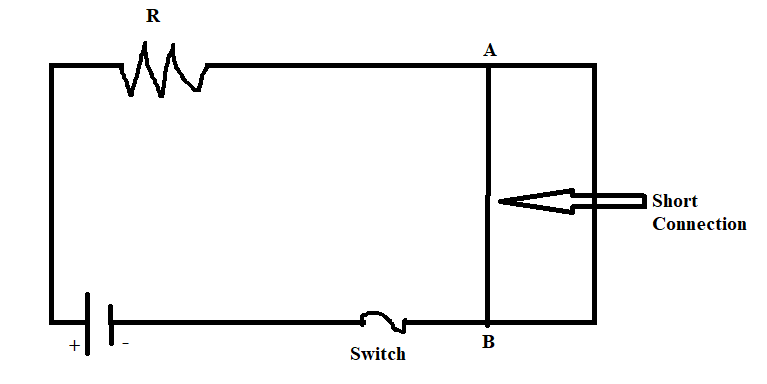
What do you mean by short-circuiting of a circuit?
Answer
504.3k+ views
Hint: Short-circuiting of an electric circuit usually occurs when the insulation over the wires breaks or there is a voltage fluctuation in the circuit. During a short circuit, the voltage across two nodes in an electric circuit becomes equal.
Complete step by step answer:
Short-circuiting in an electric circuit is defined as that condition during which the overall resistance or impedance of the circuit becomes zero or almost negligible, thereby allowing the flow of a large amount of current through the circuit. In such a condition, the current flows in the circuit in an involuntary path. Short-circuiting occurs when the live wires come in contact with the neutral wires, either directly or via a conductor.
A short circuit is represented in the diagram below:

Note: In an ideal situation, a short circuit would mean zero resistance and no voltage drop across these nodes, however, in the case of a real circuit, the resistance becomes very less but not zero, thereby allowing a very high amount of current to flow through it.
The most common scenario of a short circuit is observed when the positive and the negative terminals of a battery are connected by a conducting wire. As the wire possesses very low resistance, it allows a high amount of current to flow through it. This flow of high current in a very short time leads to the heating of the battery and may cause it to explode and cause hazardous damages.
However, damages caused by a short circuit of any form can be reduced or prevented by the use of fuses, circuit breakers, etc.
Complete step by step answer:
Short-circuiting in an electric circuit is defined as that condition during which the overall resistance or impedance of the circuit becomes zero or almost negligible, thereby allowing the flow of a large amount of current through the circuit. In such a condition, the current flows in the circuit in an involuntary path. Short-circuiting occurs when the live wires come in contact with the neutral wires, either directly or via a conductor.
A short circuit is represented in the diagram below:

Note: In an ideal situation, a short circuit would mean zero resistance and no voltage drop across these nodes, however, in the case of a real circuit, the resistance becomes very less but not zero, thereby allowing a very high amount of current to flow through it.
The most common scenario of a short circuit is observed when the positive and the negative terminals of a battery are connected by a conducting wire. As the wire possesses very low resistance, it allows a high amount of current to flow through it. This flow of high current in a very short time leads to the heating of the battery and may cause it to explode and cause hazardous damages.
However, damages caused by a short circuit of any form can be reduced or prevented by the use of fuses, circuit breakers, etc.
Recently Updated Pages
A man running at a speed 5 ms is viewed in the side class 12 physics CBSE

The number of solutions in x in 02pi for which sqrt class 12 maths CBSE

State and explain Hardy Weinbergs Principle class 12 biology CBSE

Write any two methods of preparation of phenol Give class 12 chemistry CBSE

Which of the following statements is wrong a Amnion class 12 biology CBSE

Differentiate between action potential and resting class 12 biology CBSE

Trending doubts
What are the major means of transport Explain each class 12 social science CBSE

Which are the Top 10 Largest Countries of the World?

Draw a labelled sketch of the human eye class 12 physics CBSE

How much time does it take to bleed after eating p class 12 biology CBSE

Explain sex determination in humans with line diag class 12 biology CBSE

Explain sex determination in humans with the help of class 12 biology CBSE




